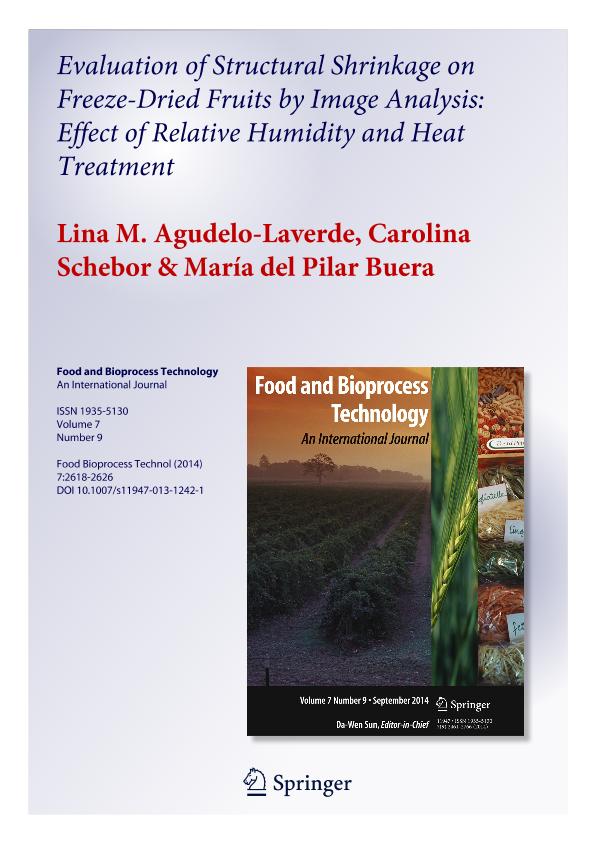Mostrar el registro sencillo del ítem
dc.contributor.author
Agudelo Laverde, Lina Marcela

dc.contributor.author
Schebor, Carolina Claudia

dc.contributor.author
Buera, Maria del Pilar

dc.date.available
2018-01-02T17:59:56Z
dc.date.issued
2014-01
dc.identifier.citation
Buera, Maria del Pilar; Agudelo Laverde, Lina Marcela; Schebor, Carolina Claudia; Evaluation of Structural Shrinkage on Freeze-Dried Fruits by Image Analysis: Effect of Relative Humidity and Heat Treatment; Springer; Food and Bioprocess Technology; 7; 9; 1-2014; 2618-2626
dc.identifier.issn
1935-5130
dc.identifier.uri
http://hdl.handle.net/11336/31994
dc.description.abstract
Stability of many dehydrated systems is related to the formation of a glass during drying. Highly porous materials, such as those prepared by freeze-drying are susceptible to shrinkage post-drying when stored at not optimal conditions. The aim of this study was to evaluate the occurrence of structural shrinkage on freeze-dried fruits through image analysis in relation to relative humidity (RH) and heat treatment. Freeze-dried fruits were humidified between 11 and 84 % RH at 25 °C for 14 days, and then stored at 45 °C. Sugar and water content, thermal transitions, and volume changes were determined. The shrinkage degree of fresh, lyophilized, humidified, and heat-treated samples was assessed by image analysis. The freeze-drying process did not produce important changes on fruits volume. At low RH values (11–22 % RH), the reduction of the cylinders volume was lower than 15 %. The maximum shrinkage values at each RH were attained in the initial period of humidification (first and second days), and then shrinkage rate decreased markedly, reaching a nearly constant value. The shrinkage degree increased with the increase in RH, reaching values up to 60 % volume reduction. During heat treatment, the volume reduction was less than 10 %. The shrinkage degree was limited by the structural characteristics of the fruits. The structural changes were strongly influenced by variables such as water content, glass transition temperatures, and storage time. In this work, the degree of shrinkage could be followed by image analysis and the use of a mechanical modeling software.
dc.format
application/pdf
dc.language.iso
eng
dc.publisher
Springer

dc.rights
info:eu-repo/semantics/openAccess
dc.rights.uri
https://creativecommons.org/licenses/by-nc-sa/2.5/ar/
dc.subject
Dehydrated Fruits
dc.subject
Shrinkage
dc.subject
Freeze-Drying
dc.subject
Glass Transition
dc.subject.classification
Otras Ciencias Químicas

dc.subject.classification
Ciencias Químicas

dc.subject.classification
CIENCIAS NATURALES Y EXACTAS

dc.title
Evaluation of Structural Shrinkage on Freeze-Dried Fruits by Image Analysis: Effect of Relative Humidity and Heat Treatment
dc.type
info:eu-repo/semantics/article
dc.type
info:ar-repo/semantics/artículo
dc.type
info:eu-repo/semantics/publishedVersion
dc.date.updated
2017-12-29T14:18:47Z
dc.identifier.eissn
1935-5149
dc.journal.volume
7
dc.journal.number
9
dc.journal.pagination
2618-2626
dc.journal.pais
Estados Unidos

dc.journal.ciudad
Nueva York
dc.description.fil
Fil: Agudelo Laverde, Lina Marcela. Universidad de Buenos Aires. Facultad de Ciencias Exactas y Naturales. Departamento de Industrias; Argentina. Consejo Nacional de Investigaciones Científicas y Técnicas; Argentina
dc.description.fil
Fil: Schebor, Carolina Claudia. Universidad de Buenos Aires. Facultad de Ciencias Exactas y Naturales. Departamento de Industrias; Argentina. Consejo Nacional de Investigaciones Científicas y Técnicas; Argentina
dc.description.fil
Fil: Buera, Maria del Pilar. Universidad de Buenos Aires. Facultad de Ciencias Exactas y Naturales. Departamento de Industrias; Argentina. Consejo Nacional de Investigaciones Científicas y Técnicas; Argentina
dc.journal.title
Food and Bioprocess Technology

dc.relation.alternativeid
info:eu-repo/semantics/altIdentifier/doi/http://dx.doi.org/10.1007/s11947-013-1242-1
dc.relation.alternativeid
info:eu-repo/semantics/altIdentifier/url/https://link.springer.com/article/10.1007%2Fs11947-013-1242-1
Archivos asociados
